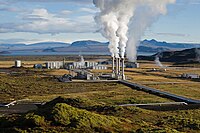
Photo from wikipedia
Captive conditions can affect the symbiotic microbiome of animals. In this study, we compared the structural and functional differences of the gastrointestinal microbiomes of wild Bactrian camels (Camelus ferus) between… Click to show full abstract
Captive conditions can affect the symbiotic microbiome of animals. In this study, we compared the structural and functional differences of the gastrointestinal microbiomes of wild Bactrian camels (Camelus ferus) between wild and captive populations, as well as their different host energy utilization performances through metagenomics. The results showed that wild-living camels harbored more microbial taxa related to the production of volatile fatty acids, fewer methanogens, and fewer genes encoding enzymes involved in methanogenesis, leading to higher energy utilization efficiency compared to that of captive-living camels. These findings suggest that the wild-living camel fecal microbiome demonstrates a series of adaptive characteristics that enable the host to adjust to a relatively barren field environment. Our study provides novel insights into the mechanisms of wildlife adaptations to habitats from the perspective of the microbiome. This article is protected by copyright. All rights reserved.
Journal Title: Integrative zoology
Year Published: 2021
Link to full text (if available)
Share on Social Media: Sign Up to like & get
recommendations!